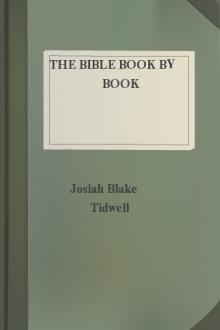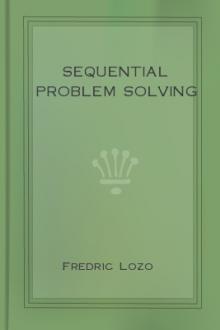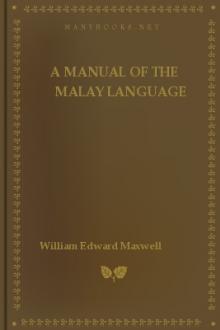The Bible Book by Book by Josiah Blake Tidwell (best short books to read .txt) 📕

- Author: Josiah Blake Tidwell
- Performer: -
Book online «The Bible Book by Book by Josiah Blake Tidwell (best short books to read .txt) 📕». Author Josiah Blake Tidwell
I. The Impending Calamity, Ch. 1.
II. The Sins That Have Brought on This Calamity. Chs. 2-3.
1. In their wickedness they refuse to hear the prophets and are led into captivity, 2:1-11.
2. The promised restoration, 2:12-13.
3. The sins of the rich and of those in authority. Ch. 3.
III. The Promised Restoration and Glory, Chs. 4-5.
1. The promised restoration of the city Zion, 4:1-5.
2. The restoration and glory of Israel, 4:6-13 (end).
3. The mighty messianic king to be given, Ch. 5.
IV. God's Controversy With Israel. Chs. 6-7.
1. God's charge and threat against them, Ch. 6.
2. In lamentation and patience the righteous must wait for a better time, 7:1-13.
3. God will have mercy and restore, 7:14-20.
For Study and discussion. (1) The several accusations and threatenings against Israel and Judah. (2) The different things mentioned to describe the coming prosperity of Israel and of the Messianic period. (3) The false authority of civil rulers, of moral leaders, of spiritual teachers.
Nahum and Habakkuk.
Nahum.
The Prophet. His name means "consolation", and he was a native of Elkosh, a small town of Galilee. We do not know where he uttered his prophecy, whether from Philistia or at Nineveh. It is thought that he escaped into Judah when the Captivity of the Ten Tribe began and that he was at Jerusalem at the time of the Assyrian invasion.
The Prophecy. The date, if the above conclusions are to be relied upon, would be in the reign of Hezekiah, King of Judah, which would be between 720 and 698 B. C. Others put it between the destruction of Thebes, 664 B. C. and the fall of Nineveh, 607 B. C. claiming that it might be either during the reign of Josiah, 640-625 B. C. or in the reign of Manasseh, 660 B. C. The theme of the book is the approaching fall of Nineveh, the capital of Assyria, which held sway for centuries and has been regarded as the most brutal of the ancient heathen nations. The purpose, in keeping with the name of the author, was to comfort his people, so long harassed by Assyria, which was soon to fall and trouble them no more. The style is bold and fervid and eloquent and differs from all the prophetic books so far studied in that it is silent concerning the sins of Judah. It is a sort of outburst of exultation over the distress of a cruel foe, a shout of triumph over the downfall of an enemy that has prevented the exaltation of the people of Jehovah.
Analysis.
I. The Doom of Nineveh Pronounced, Ch. 1.
II. the Siege and Fall of Nineveh, Ch. 2.
III. The Sins Which Will Cause Nineveh's Ruin, Ch. 3.
For Study and Discussion. (1) The striking features of the Divine character seen in the book. How many in 1:2-3? (2) The description of Nineveh-not only her wickedness, but her energy and enterprise. (3) The doom predicted for Nineveh-analyze the predictions to the different things to which she is doomed. (4) Pride as a God-ward sin and its punishment. (5) Cruelty, The man-ward sin and its punishment.
Habakkuk.
The Prophet. His name means "embracing," and he very likely was a contemporary of Jeremiah and prophesied between 608 B. C. and 638 B. C. at a time of political and moral crisis. He may have been a Levite connected with the Temple music.
The Prophecy. As Nahum prophesied the fall of Assyria for its oppression of Israel, Habakkuk tells of God's judgments upon the Chaldeans because of their oppression. The style is poetical and displays a very fine imagery. (1) There is a dialogue between the prophet and the Divine ruler. (2) There is a prayer or psalm which is said not to be excelled in any language in the grandeur of its poetical conceptions and sublimity of expression.
Its purpose grew out of the fact that they were no better off under the rule of Babylon (Chaldeans) which had overthrown Assyria than they were formerly while Assyria ruled over them. It intended to answer the questions: (1) How could God use such a wicked instrument as the Chaldeans (Barbarians) to execute his purposes? (2) Could the Divine purpose be justified in such events? God's righteousness needed vindicating to the people. (3) Why does wickedness seem to triumph while the righteous suffer? This is the question of Job, applied to the nation.
Analysis.
I. The Problem of the Apparent Triumph of Sin, Ch. 1.
1. Why does sin go unpunished? 1-4.
2. God says he has used the Chaldeans to punish sin, 5-11.
3. Are they confined to evil forever, 12-17.
II. The Impending Punishment of the Chaldeans, Oh. 2.
1. Waiting for the vision, 1-3.
2. Vision of five destructive woes, 4-20.
III. An Age of Confidence in God, Ch.3.
1. Prayer of the disquieted prophet, 1-2.
2. Past history has shown that God will finally destroy Israel's enemies, 3-15.
3. The prophet must joyously trust God and wait when in perplexity, 16-19.
For Study and Discussion. (1) The morals of the people. (2) The character and deeds of the Chaldeans. (3) The Universal supremacy of Jehovah. (4) The proper attitude amid perplexing problem. (5) Faith and faithfulness as a guarantee of supremacy and life.
Zephaniah and Haggai.
Zephaniah.
The Prophet. He is a son of Cushi, a descendant of Hezekiah, and prophesied about 630 B. C. during the reign of Josiah. His prophesies may have aided in inaugurating and in carrying to success the reforms of Josiah. His name means "hid of the Lord" in he is supposed to have been a contemporary of Habakkuk.
The Prophecy. The prophecy seems to be based upon the ravages of the Scythians, whom the nations had come to fear and whom Egypt had bribed, and looks to the judgment of the Lord which cannot be escaped. Its theme, therefore, is "The great day of the Lord" in which suffering will come upon all nations with which the prophet is familiar, Jerusalem and all Judea included. Converts would be won from all parts of the world and these could worship Jehovah, "every one from his place".
Analysis.
I. The Coming Day of Wrath. Ch. 1.
1. The destruction of all things, 1-6.
2. The severe punishment of Judah, 7-18.
II. Judgment Upon Evil Nations, 2:1-3:7.
1. A plea for repentance, 2:1-3.
2. The doom that shall engulf the nations, 2:4-end.
3. Judah's obstinacy in sin, 3:1-7.
III. Promised Blessing for the Faithful Remnant, 3:8-20
.
1. Because of Israel's sin, the nation will be cleansed by punishment and converted to God, 3:3-10.
2. Purified Israel shall be honored in all the earth, 3:11-20.
For Study and Discussion, (1) Gather a list of all that is said to induce repentance or the turning away from evil. (2) What sins are condemned in Judah and other nations. Make a list of them. (3) Name the special classes that are condemned, as princes. (4) Make a list of the blessings promised for the coming Messianic days. (5) The purpose of the Lord's judgments.
Haggai.
The Prophet. Haggai was born in Babylon and was one of those who returned from captivity, under Zerrubbabel, according to the decree of Cyrus. He prophesied during the period of the rebuilding of the temple, as recorded in Ezra and he was the first prophet called to prophesy after the Jews returned from the captivity in Babylon. He began his teaching sixteen years after the return of the first band to Jerusalem.
The Conditions Out of Which Grew the Prophecy. Under the decree of Cyrus. King of Persia, Zerrubbabel, a descendant of King David, had led a company of captives back to Jerusalem. They had set up the altar and work on the temple had been begun, but the work had been interrupted by the hostile Samaritans and others and for about fourteen years almost nothing had been done. These years of inactivity had dulled their zeal and they were rapidly becoming reconciled to the situation and by reason of their weakness, compared with the great task before them, they were beginning to despair of seeing their people and beloved city and Temple restored to that glory pictured by former prophets.
The Prophecy. Its purpose was to restore the hope of the people and to give them zeal for the cause of God. This was accomplished by means of four distinct visions, each of which shows their folly in not completing the work, mid promises divine blessing. They hear God say, "I am with you, and will bless you." The result is seen in that they are enabled, in spite of opposition, to finish and dedicate it in about four years.
Analysis.
I. The Appeal to Rebuild the Temple, Ch. 1.
1. The appeal, 1:11.
2. The preparations to build, 12-15.
II. The New Temple, 2:1-19.
1. The superior glories of it, 2:1-9.
2. The blessing of its holy service, 2:10-19.
III. The Messianic Kingdom, 2:10-23.
For Study and Discussion, (1) The rebukes uttered by the prophet. (2) The encouragements he offers. (3) The historical confirmation of the facts of this book found in Ezra. (4) False content and discontent. (5) Basing conclusions upon the comparative strength of the friends and enemies of a proposition, while leaving God out of the count.
Zechariah and Malachi.
Zechariah.
The Prophet. His name means "Remembered of the Lord" and like Haggai he appears to have been among the captives who returned from Babylon with Zerubbabel. He was a co-laborer with Haggai, beginning his work two mouths later and continuing into the second year following him. The conditions of the times were the same as those described in Haggai.
The Prophecy. The purpose is the same as that of Haggai. The time of the first eight chapters is that of the rebuilding of the temple while the remaining chapters, 9-14, are thought to have been written thirty years later. It is distinguished for: (1) The symbolic character of its visions. (2) The richness of his Messianic predictions found in the second part. (3) The large place given to angelic mediation in the intercourse with Jehovah.
The Contents. The contents have been said to contain: (1) Encouragements to lead the people to repent and reform; (2) Discussions about keeping up the days of fasting and humiliation observed during the captivity; (3) Reflections of a moral and spiritual nature; (4) Denunciations against some contemporary nations; (5) Promises of the prosperity of God's people; (6) Various predictions concerning Christ and his kingdom.
Analysis.
I. Eight Visions Encouraging the Rebuilding of the Temple, Chs. 1-6. Introduction, 1:1-6.
1. The horseman among the myrtle trees, 1:7-17.
2. The four horns and four carpenters, 1:18-21.
3. The man with the measuring line, Ch. 2.
4. Joshua, the High Priest, and Satan, Ch. 3.
5. The Golden Candlestick, Ch. 4.
6. The Flying Roll 5:1-4.
7. The woman and ephah, 5:5-11 end.
8. The four war chariots, 6:1-8.
Appendix: Joshua crowned as a type of Christ, 6:9-15.
II. Requirement of the Law and the Restoration and Enlargement of Israel, Chs. 7-8.
1. Obedience better than fasting. 7:1-7.
2. Disobedience the source of all their past misery, 7:8-14 end.
3. The restoration and enlargement which prefigure Christ "The Jew," Ch.8.
III. Visions of the Messianic Kingdom. Chs. 9-14.
1. The Messianic King, Ch. 9-10.
2. The rejected Shepherd, Ch. 11.
3. The restored and penitent people, Chs. 12-13.
4. The divine sovereignty, Ch. 14.
For Study and Discussion. (1) The symbols and figures used in the several visions. (2) The different ways of expressing or planning the success of God's people and the overthrow of their enemies. (3) The discussion of fasting, should they keep it up? What is superior to it? etc. (4) The promises of these prophesies. (5) The denunciations and judgments found in the book.
Malachi.
The Prophet. His name means "Messenger of the Lord." or "My Messenger". He was connected with the reform movement of Nehemiah and Ezra and condemned the same sins which they condemned. He must, therefore, have lived about 100 years after Haggai and Zechariah, or about 430-420 B. C. He was the last of the Old Testament inspired prophets.
The Condition of the Time. The people had





Comments (0)